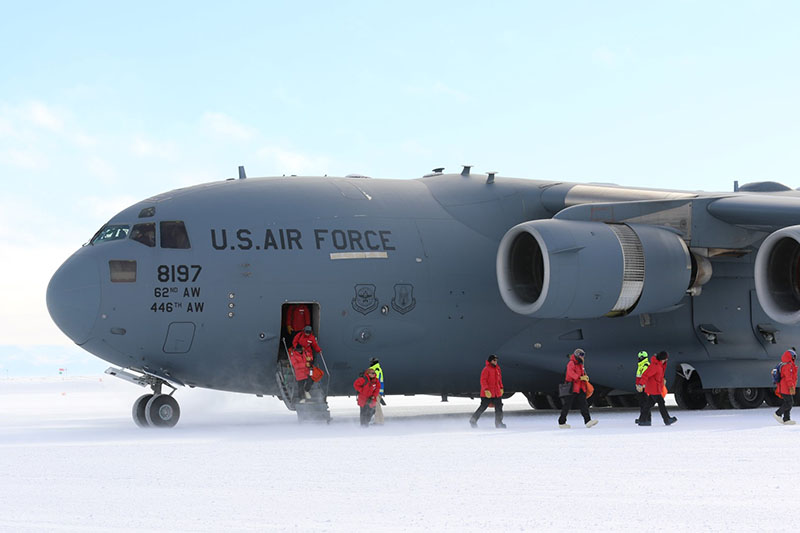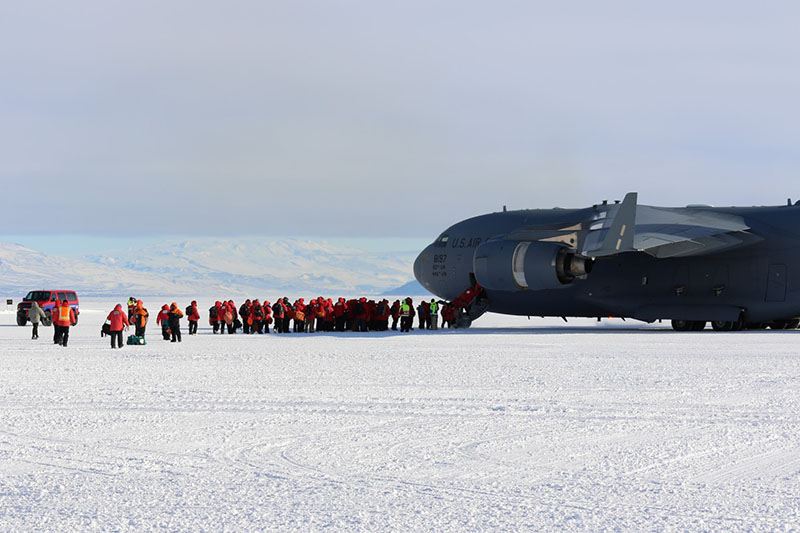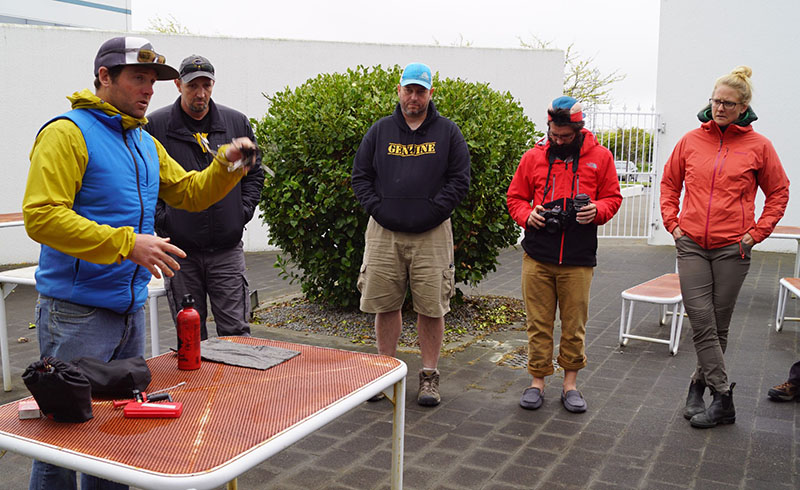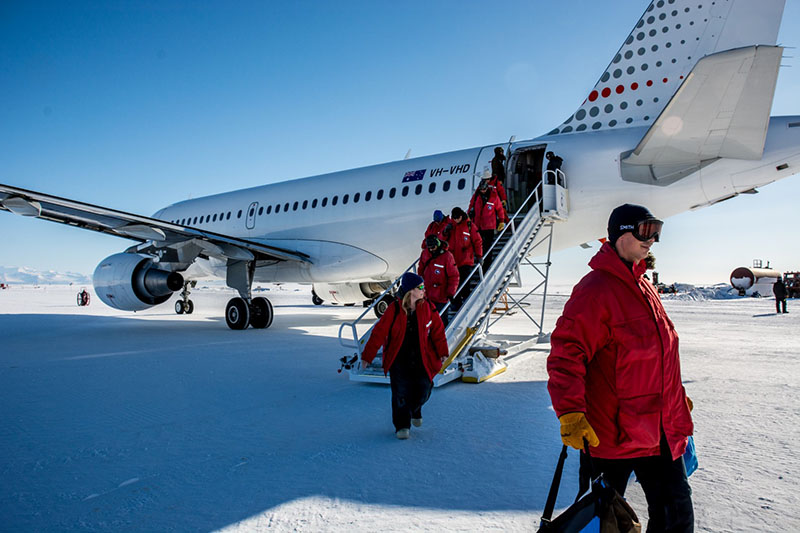
Photo Credit: Jack Green
|
The first C-17 of the summer season delivers researchers and support staff to McMurdo Station after a two-week weather delay. |
Science Bouncing Back From a Delayed Start
After an extended weather delay, the research program kicks into gear at McMurdo Station
By Mike Lucibella
Posted October 23, 2018
The first planes of the 2018-2019 Summer Season touched down at McMurdo Station’s Phoenix Airfield at 3 pm in the afternoon on October 16 after more than two weeks of weather delays, the longest postponement of season-opening in recent memory.

Photo Credit: NSF
A series of at times severe storms over the first half of October prevented any airplanes from flying into McMurdo Station until October 16th.
Delays of up to a few days are common for researchers and support staff flying to McMurdo Station, Antarctica from Christchurch, New Zealand. However, a fifteen-day flight hiatus is very unusual.
The first flights from Christchurch to McMurdo were originally scheduled for October 1, but throughout early October, a series of low-pressure systems parked over the region and brought days of bad weather, blowing snow and poor visibility.
Jessie L. Crain, the Antarctic research support manager in the Office of Polar Programs at the National Science Foundation (NSF), said that it is too soon yet to say definitively what the effects of the delay will be on the science program.

Photo Credit: Jack Green
After the storms, the Phoenix Airfield had to be groomed and smoothed to allow the wheeled C-17s to safely touchdown.
She noted that while the temptation is to think in isolation of what to do with each part of the program affected by the delays, the reality is that every project and choice is part of a large and complex decision-making matrix, in which a change in one may well affect many others.
“In partnership with the research community, our logistics contractor and our military and civilian partners, we need to take a look at the larger puzzle and plan a way forward and that takes time and care and focuses on optimizing the use of the time remaining in the season,” she said.
For example, among those who were laid over in Christchurch—and were among the first to arrive on two flights that were successful during the week of Oct. 15—were helicopter pilots and mechanics, without whom it is not possible to get materials into the field to establish camps or personnel to conduct science.

Photo Credit: Jack Green
The first C-17 of the summer season flies in for a landing at Phoenix Airfield.
While airplanes previously did not fly to McMurdo Station during the austral winter because of the persistent cold temperatures and the inherent dangers of landing during the 24-hour darkness, the use of night-vision goggles by Air Force pilots has allowed the NSF-managed U.S. Antarctic Program to schedule a limited number of mid-winter flights.
The more frequent airlift for the busy summer season, known as “Mainbody,” begins usually around late September or early October and it is those flights that have been delayed.
Weather in Antarctica is tricky to forecast as weather stations across the continent are sparse and data is limited. Satellite weather systems fill the gaps, but reliable, long-term predictions are still difficult.
In order to safely land the C-17 Globemaster and Airbus A319 planes on the compacted-snow Phoenix ice runway, the airfield crews needed about a day to clear away drifted snow and smooth the landing strip. The spates of bad weather came so frequently in October that there was never the chance to fully clear the runway for any planes to get in.

Photo Credit: Jack Green
Support staff who had been at the station all winter, and in some cases for more than a year, line up to fly home.
Department heads have been working from the Antarctic Program offices in Christchurch to replan and reprioritize how multiple different tasks can be accomplished.
“One of the very highest priorities is to finish construction of the new Williams Airfield, which moved locations by a couple of miles,” said Julie Grundberg, the area manager for the Antarctic Support Contract, NSF’s Denver-based logistics contractor. “We need to have it ready for the Air National Guard to start flights within a couple of weeks, and it is critical to the success of Pole and all the deep field camps.”
A number of researchers who had planned to fly in during the first part of the season are also in the process of reassessing some of their plans for the season. One of the biggest concerns is the limited amount of time to take full advantage of the sea ice, the layer of frozen ocean adjacent to the station thick enough to support people and vehicles. In the beginning of the summer season, numerous research teams travel out on it to study everything from seals that live and breed on top of it, to the ocean life that lives underneath the surface.

Photo Credit: Elaine Hood
While still in Christchurch, field safety coordinator Andrew Bond teaches the Antarctic Field Safety class, a safety lesson that would normally be taught while on station.
“People supporting our project have done a great job of getting us what we need and getting our team trained quickly,” said Jay Rotella, the principal investigator of a project studying the population of Weddell seals in the region. “We have a lot of returning team members this year and will benefit from all that experience. If the weather is at all decent in the coming week, we should be able to be right on track by late October, which is good because October 29 is the peak of pupping when 100 pups could be born per day and we'll have maximum opportunities to collect information on newborns and their mothers.
During their time delayed in Christchurch, personnel attended environmental and safety trainings that otherwise would have been taken upon arrival to Antarctica. Utilizing this time in New Zealand will enable them to hit the ground running once they reach “the Ice.”

Photo Credit: Mike Lucibella
To help move people as quickly as possible, an Airbus A319 helped fly researchers and support staff in as well.
In addition to numerous researchers and support staff trying to fly to the station, more than sixty personnel who had spent the entire winter at McMurdo Station, and in some cases a full year, were looking forward to seeing green grass, flowers, and warmer temperatures.
Despite the delays to the start of the season, researchers and support staff are still looking forward to a busy and successful science season.
“The qualities that draw people to a place like Antarctica (adaptability, resilience, creativity) are the same traits that allow us, as a community, to bounce back when we’re challenged in this way,” said Grundberg. “We’ll work as efficiently as possible while still making sure we’re not overextending people. We’ll achieve whatever we’re capable of while still focusing on keeping folks safe. I have confidence we’ll rise to this challenge like we do all the others.”











